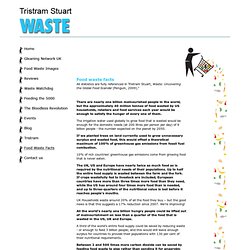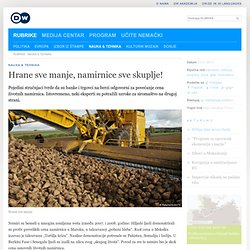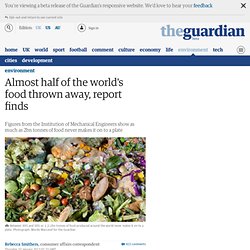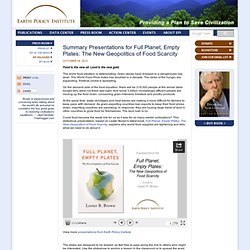

First Global Assessment of Land and Water ‘Grabbing’ As world food and energy demands grow, nations and some corporations increasingly are looking to acquire quality agricultural land for food production.

Some nations are gaining land by buying up property -- and accompanying water resources -- in other, generally less wealthy countries. Sometimes called "land grabbing," this practice can put strains on land and water resources in impoverished countries where the land, and needed water, has been "grabbed" for commercial-scale agriculture. A new study by the University of Virginia and the Polytechnic University of Milan, and currently published in the online edition of the Proceedings of the National Academy of Sciences, provides the first global quantitative assessment of the water-grabbing phenomenon, which has intensified in the last four years largely in response to a 2007-08 increase in world food prices.
"Over less than a decade, the rates of land and water grabbing have dramatically increased," said Paolo D'Odorico, Ernest H. Don't Ignore the Drought. WASTE. All statistics are fully referenced in Tristram Stuart, Waste: Uncovering the Global Food Scandal (Penguin, 2009).”

There are nearly one billion malnourished people in the world, but the approximately 40 million tonnes of food wasted by US households, retailers and food services each year would be enough to satisfy the hunger of every one of them. The irrigation water used globally to grow food that is wasted would be enough for the domestic needs (at 200 litres per person per day) of 9 billion people - the number expected on the planet by 2050. If we planted trees on land currently used to grow unnecessary surplus and wasted food, this would offset a theoretical maximum of 100% of greenhouse gas emissions from fossil fuel combustion. 10% of rich countries' greenhouse gas emissions come from growing food that is never eaten.
The UK, US and Europe have nearly twice as much food as is required by the nutritional needs of their populations. 24 to 35% of school lunches end up in the bin. Hunger & Food Security. Hrane sve manje, namirnice sve skuplje! Nemiri su besneli u mnogim zemljama sveta između 2007. i 2008. godine: Hiljade ljudi demonstrirali su protiv prevelikih cena namirnica u Maroku, u takozvanoj „pobuni hleba“.

Rast cena u Meksiku izazvao je takozvanu „Tortilja krizu“. Nasilne demonstracije potresale su Pakistan, Somaliju i Indiju. U Burkini Faso i Senegalu ljudi su izašli na ulicu zvog „skupog života“. Povod za sve te nemire bio je skok cena osnovnih životnih namirnica. Namirnica za sada još uvek ima dovoljno Cene pirinča, pšenice, kukuruza i soje višestruko su se uvećale između juna 2007. i juna 2008.
Mnogi kažu da su za to odgovorne špekulacije na tržištu životnih namirnica. Sporna krivica špekulanata. Trgovcima jeftinije hranu bacati nego dijeliti sirotinji. 'Pisali smo svim trgovačkim centrima da hranu s valjanim rokom trajanja poklone umjesto da je stavljaju u otpis.

No odgovorili su nam da je to njima prevelik posao koji iziskuje zapošljavanje još bar jednog djelatnika i doslovce su nam rekli da im je lakše i jeftinije hranu baciti u kontejner', kaže Olivera Balatinac, voditeljica Centra za prihvat beskućnika u Caritasu Đakovačko-osječke nadbiskupije Trenutno ostvaruje tek suradnju s jednim trgovačkim centrom odakle dobivaju kruh, a samo im je Getro svojevremeno jednom mjesečno pri utvrđivanju rashoda poklanjao hranu. Neke tvornice, kaže, proizvode koji su pred istekom roka trajanja stave u prodaju po pristupačnijoj cijeni i Caritas ih tada otkupi.
Almost half of the world's food thrown away, report finds. As much as half of all the food produced in the world – equivalent to 2bn tonnes – ends up as waste every year, engineers warned in a report published on Thursday.

The UK's Institution of Mechanical Engineers (IMechE) blames the "staggering" new figures in its analysis on unnecessarily strict sell-by dates, buy-one-get-one free and Western consumer demand for cosmetically perfect food, along with "poor engineering and agricultural practices", inadequate infrastructure and poor storage facilities. In the face of United Nations predictions that there could be about an extra 3 billion people to feed by the end of the century and growing pressure on the resources needed to produce food, including land, water and energy, the IMechE is calling for urgent action to tackle this waste.
Bookstore - Full Planet, Empty Plates: The New Geopolitics of Food Scarcity. EPI Releases - Summary Presentations for Full Planet, Empty Plates: The New Geopolitics of Food Scarcity. Summary Presentations for Full Planet, Empty Plates: The New Geopolitics of Food Scarcity October 04, 2012 Food is the new oil.

Land is the new gold. The world food situation is deteriorating. Grain stocks have dropped to a dangerously low level. On the demand side of the food equation, there will be 219,000 people at the dinner table tonight who were not there last night. At the same time, water shortages and heat waves are making it more difficult for farmers to keep pace with demand. Could food become the weak link for us as it was for so many earlier civilizations? View more presentations from Earth Policy Institute The slides are designed to be shared, so feel free to pass along the link to others who might be interested. If you find this tool useful, please let us know how you are using it in your community, classroom, or congregation by sending an e-mail to epi@earthpolicy.org.
Remember, we all have a role to play. Further instructions: